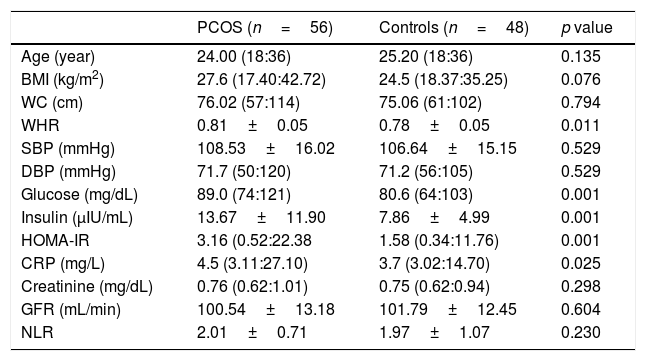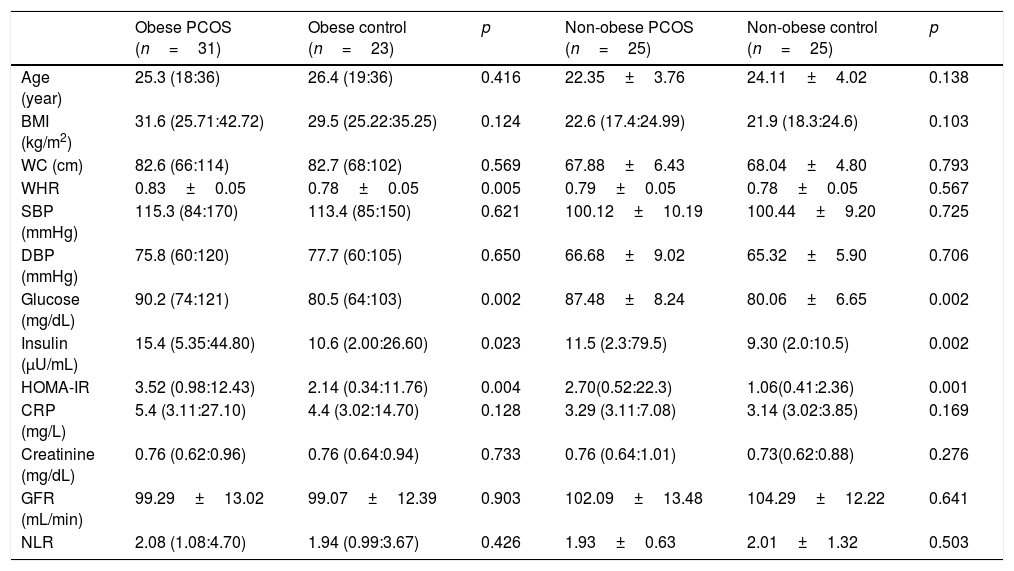To investigate the relationship between glomerular filtration rates (GFR), and homeostasis model assesment of insulin resistance (HOMA-IR), C-reactive protein (CRP) and neutrophil to lymphocyte ratio (NLR) in patients with polycystic ovary syndrome (PCOS).
Material and methodsThirty-one overweight and obese PCOS patients with body mass index (BMI)≥25kg/m2 and 25 non-obese PCOS patients with BMI<25kg/m2 were included into patients’ group, while 23 overweight and obese, and 25 non-obese age-and BMI-matched healthy individuals (aged between 18 and 40 years), were enrolled as controls. Levels of serum creatinine, glucose, insulin, CRP, and complete blood count were measured. eGFR, HOMA-IR and NLR were also calculated.
ResultsIn PCOS group, HOMA-IR (p=0.001), CRP (p=0.025) and waist hip ratio (WHR) (p=0.011) were higher than controls. In obese PCOS sub-group, HOMA-IR (p=0.004) and WHR (p=0.002) were higher than obese controls. In non-obese PCOS sub-group, HOMA-IR (p=0.001) were higher than non-obese controls. In obese PCOS sub-group; HOMA-IR (p=0.001) and CRP (p=0.001) levels were significantly higher than non-obese PCOS sub-group. In terms of other parameters, no significant difference was found between the groups. The analysis showed a negative correlation between GFR, and BMI and HOMA-IR in PCOS group, between GFR, WHR and insulin levels in obese PCOS sub-group, and between BMI, and HOMA-IR and NLR in non-obese PCOS sub-group.
ConclusionAlthough HOMA-IR and CRP were higher in PCOS group, there was no difference in NLR and GFR levels between those with PCOS and controls.
investigar la relación entre las tasas de filtración glomerular (TFG) y la evaluación del modelo de homeostasis de la resistencia a la insulina (HOMA-IR), la proteína C-reactiva (PCR) y la relación de neutrófilos a linfocitos (NLR) en pacientes con síndrome de ovario poliquístico (PCOS).
Material y métodosTreinta y un pacientes con PCOS con sobrepeso y obesidad con índice de masa corporal(IMC) ≥25 kg/m 2 y 25 pacientes con PCOS no obesos con IMC <25 kg/m 2 constituyeron el grupo de pacientes, mientras que 23 con sobrepeso y obesidad, y Se inscribieron como controles 25 sujetos sanos no obesos, todos con edad e IMC(edad entre 18 y 40 años). Se midieron los niveles séricos de creatinina, glucosa, insulina y PCR, y se evaluó el recuento sanguíneo completo; Se calcularon eGFR, HOMA-IR y NLR.
Resultadosen el grupo PCOS, HOMA-IR (p=0.001), CRP (p=0.025) y la relación cintura-cadera(WHR) (p=0.011) fueron más altos que los controles. En el subgrupo de PCOS obesos, HOMA-IR (p=0.004) y WHR (p=0.002) fueron más altos que los controles obesos. En el subgrupo PCOS no obeso, HOMA-IR (p=0.001) fue mayor que los controles no obesos. En el subgrupo de PCOS obesos; Los niveles de HOMA-IR (p=0.001) y CRP (p=0.001) fueron significativamente más altos que los del subgrupo PCOS no obeso. En cuanto a otros parámetros, no se encontraron diferencias significativas entre los grupos.
ConclusiónAunque los niveles de HOMA-IR y CRP se encontraron más altos en el grupo PCOS, no hubo diferencias en los niveles de NLR y GFR entre aquellos con PCOS y controles.
Artículo
Comprando el artículo el PDF del mismo podrá ser descargado
Precio 19,34 €
Comprar ahora









